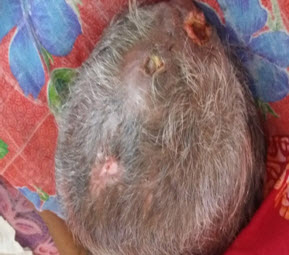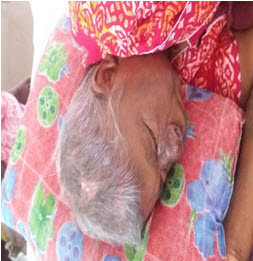{ DOWNLOAD AS PDF }
ABOUT AUTHORS
Byreddy sowmya*, Gandluri sravani, Hari Priya Mullamuri.
Sri Padmavathi School of pharmacy,
Jawaharlal Nehru Technological University,
Anantapuram, Andhra Pradesh, India
ABSTRACT
Any medication used for diagnosis, prophylaxis or treatment of the patient is capable of producing an adverse reaction. Allergy is the most common unexpected adverse reaction; encountered with antibiotics, salicylates, ACE (angiotensin converting enzyme) inhibitors and dye agents. Paraphenylenediamine (PPD) is a chemical substance that is widely used as a permanent hair dye. PPD is used in hair dye because it is a permanent dye that gives a natural look, and the dyed hair can also be shampooed or permed without losing its colour. Fully oxidized PPD is not a sensitiser, but the intermediate, partially oxidised form of PPD may cause contact allergic dermatitis in sensitive individuals.In this case report we discuss about the ppd allergy in the older person who are having diabetes ,hypertension and heart diseases. The case is being reported to bring attention of the medical fraternity towards importance of sound pharmaco-vigilance and prepare them to with efficient preventive measures before using of these dyes. This case can also provide a vital data regarding anaphylactic reaction to a dye.
Reference Id: PHARMATUTOR-ART-2661
|
PharmaTutor (Print-ISSN: 2394 - 6679; e-ISSN: 2347 - 7881) Volume 7, Issue 04 Received On: 16/03/2019; Accepted On: 26/03/2019; Published On: 01/04/2019 How to cite this article: Byreddy, sowmya, Gandluri, S. and Mullamuri, H.P. 2019. Dye Induced Reaction in geriatric patient with comorbid conditions at a Tertiary Care Teaching Hospital. PharmaTutor. 7, 4 (Apr. 2019), 60-62. DOI:https://doi.org/10.29161/PT.v7.i4.2019.60. |
INTRODUCTION:
Para-phenylenediamine (PPD) was first described by Hofmann in 18631 and formulated to use in hair dye at the end of the 19th century. It is a preferred constituent in many hair dyes in view of the longer lasting nature and black, natural appearing pigmentation imparted to the hair (Ambika Prasad Patr,2015). Ppd is usually mixed with peroxide in the dye to alter the hair color ,it is more likely to interact with the skin and cause an allergic reaction(Dorra Amira,2015). ppdis not known to be carcinogenic but it has been liked o reversal health problems.exposure routes through inhalation,skin absorption ingestion eye contact.symptoms of exposure include angioedema,blisters,sensitization dermatitis(Fabiola kind ,2012). In addition to skin it affects respiratory and gastrointestinal systems and presents with laryngeal swelling that can be life threatening. It is important to recognise the condition early so not to give inappropriate treatment (Hilal Gokalp,2014).
CASE REPORT :

Image : 1

Image : 2
A 63 yrs old female patient was admitted in department of general medicine at svrrggh hospital, with a 1 week history of blisters in head, pus discharge ,severe swelling of face,marked periorbital edema .which developed over 2days back there wasnhistory of previous sensitization with the use of black henna (or)hair dye. Patient wask/c/o cad/htn/dm-2,uncontrolled sugar levels ,these factor mainly trigger the reaction in this patient.she was already taken medicine for treating complications such as Amlodipine 5 mg for HTN ,inj.insulin, human mixtard 3u ,aspirin 75mg.she was initially treated at local hospital and given amoxicillinfor apressumed diagnosis of celulitis ,she was taken to the hospital ,on day 3 of symptoms where she received Pipertz 4.5g,metrogyl,human mixtard, Amlodipine.this made no improvement and patient was reffered to surgery(scalp absess done by using LA10-15 ml of fluid drained) she had severe facial edema with marked periorbital edema. there was no swelling of the tongue, she had blisters on the scalp, after surgery the patient was admitted in general medicine ward. taking medication aspirin. metrogyl, Pipertz, human mixtuard, topically she received clobetasol cream to her face .patient was made partially recovery because his past history diseases. Discharged and prescribe cetomacrogel and fluocinolone gel for scalp and 1%hydrocortisone for the face, and other drugs for the treatment of HTN/CAD/T2 DM.
DISCUSSION:
Reactions to hair dyes are common and range from mild to severe and life threatening. They include contact dermatitis, angio edema and anaphylaxis. These are caused by PPD contained in hair dyes. The complications of PPD include airway obstruction, Angioedema-like allergic contact dermatitis related to black henna has been reported before. This was a 63 year old woman who had a mild contact dermatitis to black henna with prior sensitization (Ambika Prasad Patr,2015). There was no history of prior sensitization in our patient. Henna is a green powder obtained from a plant (Hilal Gokalp,2014). No natural black henna exists and black henna is a combination of henna with PPD. PPD is a known sensitizer and PPD reactions can result in death (Fabiola kind,2012)( Haluk akar h,2014).is important to dilute PPD when doing a patch test to avoid sensitization. There had been a linear trend in the increased sensitization to PPD in patch tests over the years from 2% to 7% (Jacqueline matulich,2005). Because of the dangers associated with PPD, it is banned in most European countries such as Germany, France and Sweden and has been labelled an occupational health hazard (Dorra Amira,2015). It is recommended that lower concentrations between 0.5%-1 percent PPD should be used in patch tests for those who had previously used henna tattoos and in children and must be left for 24 hours (Petra spornraft-ragaller,2012). Most people are unaware of the differences between red and black henna. They may also be unaware of the dangers of PPD in black henna. It is important for strict labeling of henna as to the presence of PPD. It is important to dilute PPD when doing a patch test to avoid sensitization. There had been a linear trend in the increased sensitization to PPD in patch tests over the years from 2% to 7% (Jacqueline matulich,2005). Because of the dangers associated with PPD, it is banned in most European countries such as Germany, France and Sweden and has been labeled an occupational health hazard (Dorra Amira,2015). It is recommended that lower concentrations between 0.5%-1 percent PPD should be used in patch tests. Most people are unaware of the black henna. They may also be unaware of the dangers of PPD in black henna it is contraindicated to diabetes patients. It is important for strict labeling of henna as to the presence of PPD and dangers linked with it.
CONCLUSION:
Even the first dose of PPD can cause anaphylactoid reaction, especially in the older persons with diabetes, hypertension and heart diseases, so they have to be most cautious during the application of hair dyes. PPD is used as an excipient during the preparation of traditional cosmetics to maintain the fixation of dark color. This substance can cause serious health problems. Therefore, a regulatory decision should be taken by the government to control the use of PPD in cosmetic products. Thus reporting of such type of adverse drug reaction is very much fruitful for dealing in future with these reactions for wellness of community.
REFERENCES:
1. Ambika Prasad Patr, Kusa Kumar Shaha, Anand P. Rayamane, Shreemanta Kumar Dash, Manoj Kumar Mohanty, and Sachidananda Mohant. (2015); Paraphenylenediamine Containing Hair Dye An Emerging Household Poisoning; the American journal of forensic medicine and pathology; 36(3);1-5.
2. Dorra Amira, Ines Gana, Anouar Nouioui, Fathia Khlifi, Dorra Ben Salah, Wafa Masri, Ines Belwaer, Hayet Ghorbel, Abderrazzek Hedili (2015); Paraphenylenediamine Poisoning in Tunisia: A Case Report; Arab Journal of Forensic Sciences and Forensic Medicine; 1(1); 138-142.
3. Fabiola kind, kathrin scherer,andreas j .bricher. (2012); Contact dermatitis to para‐phenylenediamine in hair dye following sensitization to black henna tattoos – an ongoing problem; journal of the German society of dermatology; 10(8); 572-577.
4. Hilal Gokalp , Kismet Kaya , Malatya (2014); Angioedema-like allergic contact dermatitis related to black henna; Dermatology Online Journal; 20(2);1-5.
5. Haluk akar h ,adatepe s,tahan f,solmaz I (2014); Hair dyes and temporary tattoos are a real hazard for adolescents; European annals of allergy and clinical immunology; 46(1);35-37.
6. Jacqueline matulich, johns Sullivan (2005); A temporary henna tattoo causing hair and clothing dye allergy; contact dermatitis (environmental and occupational dermatitis); 53(1);33-36.
7. Petra spornraft-ragaller,eva kammerer,claus gillitzer,jochen Schmitt (2012); Severe allergic reactions to para‐phenylenediamine in children and adolescents: should the patch test concentration of PPD be changed; journal of the German society of dermatology; 10(4); 258-263.
NOW YOU CAN ALSO PUBLISH YOUR ARTICLE ONLINE.
SUBMIT YOUR ARTICLE/PROJECT AT editor-in-chief@pharmatutor.org
Subscribe to Pharmatutor Alerts by Email
FIND OUT MORE ARTICLES AT OUR DATABASE









